AM
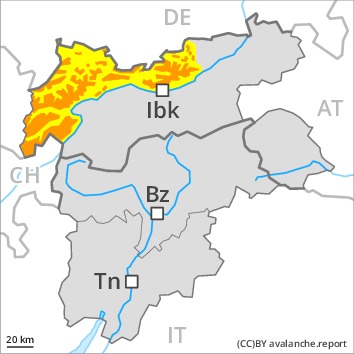
Danger level
 | 1900m
|
Avalanche Problem
 | | Persistent weak layer |
|  | |  |
 | | Gliding snow |
|  | |  |
PM
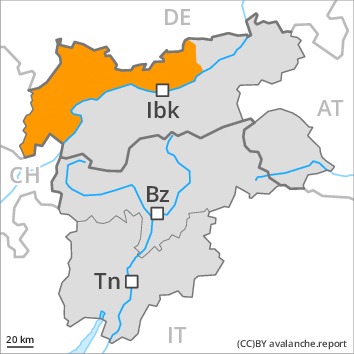
Danger level
 | 1900m
|
Avalanche Problem
 | | Persistent weak layer |
|  | |  |
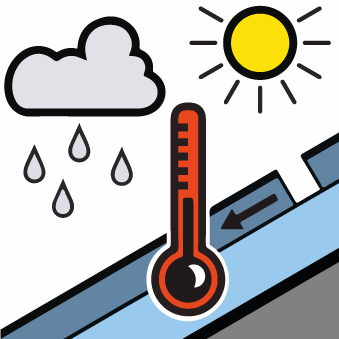 | | Wet snow |
|  | |  |
As a consequence of warming during the day and solar radiation more frequent wet and gliding avalanches are possible. In some places avalanches can be released in the weakly bonded old snow and reach large size.
The danger of wet and gliding avalanches will increase during the day. The avalanche prone locations are to be found in all aspects below approximately 1900 m and on very steep sunny slopes below approximately 2400 m. Avalanches can reach large size.
Dry avalanches can additionally be released in the weakly bonded old snow by a single winter sport participant. This applies above approximately 1900 m, especially in areas where the snow cover is rather shallow, as well as at transitions from a shallow to a deep snowpack. Between approximately 1900 and 2300 m the avalanche prone locations are more prevalent and the danger is slightly greater. Avalanches can penetrate deep layers and reach dangerously large size. Remotely triggered avalanches are possible. Experience and restraint are required.
In particular in the vicinity of peaks sometimes avalanche prone wind slabs will form.
Snowpack
dp.7: snow-poor zones in snow-rich surrounding
dp.10: springtime scenario
The spring-like weather conditions will give rise to increasing moistening of the snowpack, especially at low and intermediate altitudes, as well as on very steep sunny slopes below approximately 2400 m.
Avalanche prone weak layers exist in the centre of the snowpack, especially between approximately 1900 and 2300 m in all aspects. Released avalanches and stability tests confirm the existence of a weak snowack.
Tendency
The danger of wet and gliding avalanches will increase during the day.
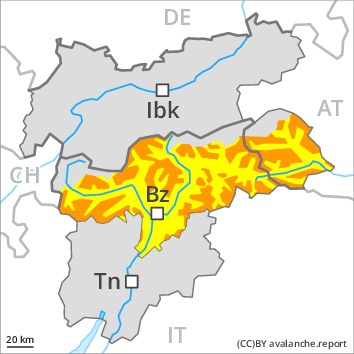
Danger level
 | 1900m
|
Avalanche Problem
 | | Persistent weak layer |
|  | |  |
 | | Wet snow |
|  | |  |

Weakly bonded old snow requires caution. As the day progresses, wet and gliding avalanches are possible.
Weak layers in the old snowpack can still be released in some places by individual winter sport participants. Caution is to be exercised in all aspects above approximately 1900 m, especially on very steep slopes, as well as at transitions from a shallow to a deep snowpack. Avalanches can also penetrate deep layers and reach dangerously large size. In addition the fresh wind slabs at high altitudes and in high Alpine regions are prone to triggering in some cases.
As a consequence of warming during the day and solar radiation moist avalanches are to be expected, especially on sunny slopes. In addition there is a danger of gliding avalanches, this also applies on shady slopes. Avalanches can reach quite a large size.
Experience in the assessment of avalanche danger is required.
Snowpack
dp.7: snow-poor zones in snow-rich surrounding
dp.10: springtime scenario
Faceted weak layers exist in the centre of the snowpack. This applies in particular above approximately 1900 m.
The mostly small wind slabs of yesterday are in some cases still prone to triggering, in particular on very steep northwest, north and east facing slopes and in high Alpine regions.
Towards its base, the snowpack is largely stable.
The spring-like weather conditions will give rise to increasing moistening of the snowpack below approximately 2400 m. Very steep sunny slopes and low and intermediate altitudes: The snowpack is moist and its surface has a melt-freeze crust that is not capable of bearing a load.
Tendency
The spring-like weather conditions will give rise to a loss of strength within the snowpack.

Danger level
 | 1900m
|
Avalanche Problem
 | | Persistent weak layer |
|  | |  |
 | | Wet snow |
|  | |  |

In some places avalanches can be released in the weakly bonded old snow and reach large size. As a consequence of warming during the day and solar radiation wet and gliding avalanches are possible.
The danger of wet and gliding avalanches will increase a little during the day. The avalanche prone locations are to be found in all aspects below approximately 1900 m and on very steep sunny slopes below approximately 2400 m. Avalanches can reach large size in isolated cases.
Dry avalanches can additionally be released in the weakly bonded old snow by a single winter sport participant. This applies above approximately 1900 m, especially in areas where the snow cover is rather shallow, as well as at transitions from a shallow to a deep snowpack. Between approximately 1900 and 2300 m the avalanche prone locations are more prevalent and the danger is slightly greater. Avalanches can penetrate deep layers and reach dangerously large size. Remotely triggered avalanches are possible. Experience and restraint are required.
In particular in the vicinity of peaks sometimes avalanche prone wind slabs will form.
Snowpack
dp.7: snow-poor zones in snow-rich surrounding
dp.10: springtime scenario
The spring-like weather conditions will give rise to increasing moistening of the snowpack, especially at low and intermediate altitudes, as well as on very steep sunny slopes below approximately 2400 m.
Avalanche prone weak layers exist in the centre of the snowpack, especially between approximately 1900 and 2300 m in all aspects. Released avalanches and stability tests confirm the existence of a weak snowack.
Tendency
The danger of wet and gliding avalanches will increase during the day.
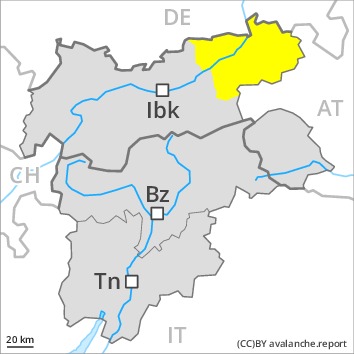
Danger level
 | 1900m
|
Avalanche Problem
 | | Persistent weak layer |
|  | |  |
 | | Wet snow |
|  | |  |

As a consequence of warming during the day and solar radiation mostly small moist snow slides are possible as the day progresses.
As a consequence of warming during the day and solar radiation individual moist avalanches are possible as the day progresses, but they will be mostly small. Caution is to be exercised in particular on extremely steep sunny slopes.
Weak layers in the old snowpack can still be released in some places by individual winter sport participants in particular above approximately 1900 m.
Snowpack
dp.7: snow-poor zones in snow-rich surrounding
dp.10: springtime scenario
Avalanche prone weak layers exist in the centre of the snowpack. This applies in particular above approximately 1900 m. The spring-like weather conditions will give rise to gradual moistening of the snowpack. The snowpack will be moist at intermediate altitudes. The snowpack will be wet all the way through at low altitude.
Tendency
Increase in danger of moist and wet avalanches.



















